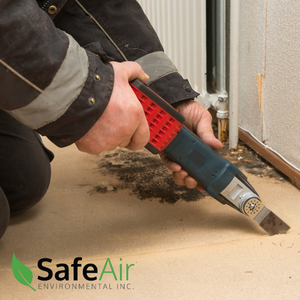11 Most Common Places to Inspect for Mold in Toronto
Posted in Mold, on January 17, 2022
 In big cities like Toronto, mold is an issue that affects homes of all types. Mold inspection in Toronto with SafeAir can help you discover hidden colonies and safeguard against future infestations. Mold will grow in any room of your home, but there are specific areas that are at greater risk.This article will share the top 11 rooms that return positive results during mold testing in Toronto.
In big cities like Toronto, mold is an issue that affects homes of all types. Mold inspection in Toronto with SafeAir can help you discover hidden colonies and safeguard against future infestations. Mold will grow in any room of your home, but there are specific areas that are at greater risk.This article will share the top 11 rooms that return positive results during mold testing in Toronto.
1. The Kitchen
Mold needs water to thrive, which is why you’ll find it growing in rooms where there is a lot of moisture — and the kitchen certainly has lots of wet areas! The dishwasher, sink, and areas nearby to those places may absorb splashed or leaking water and promote mold growth. Cooking adds moisture to a room, too — think of all that steam a bubbling pot of water creates!
2. The Bathroom
Like the kitchen, the bathroom is another area where water is plentiful. Water splashing from the bath, hot steamy showers, and leaky drains are common bathroom problems that encourage mold growth. Installing an exhaust fan or cracking the window while bathing are two simple ways to cut down on bathroom moisture.
3. The Bedroom
Wet clothes in the laundry bin and insufficient air circulation are two common causes of mold in the bedroom. If you have an ensuite bathroom, you may also experience humidity transfer from there. The number one area for mold growth in the bedroom? Overstuffed closets full of textiles, cardboard, and damp clothing.
4. The Basement
At SafeAir, we often start mold tests in the basement, especially when our clients live in flood-prone areas. The basement is particularly prone to mold infestation because it has fewer windows, reduced airflow, and piping, drains, and other ways that water can collect. Mold testing in Toronto can help root out hidden mold infestations in the dark corners of your basement.
5. The Laundry Room
Washing machines are often so large and unwieldy that we never move or inspect them thoroughly — which can let leaks, drips, and condensation build for years. This is a widespread problem in some condos with tiny, closet-like laundry areas.
6. The Attic
At the top of your home, the attic is another space commonly affected by mold growth. Attics can have mold problems caused by many issues, such as pests, leaks, roof damage, ice damming, old insulation, and poor ventilation. Attic mold growth in Toronto is easy to avoid with simple changes like improved insulation and ventilation.
7. The Crawlspace
Mold growth affects the crawlspace for similar reasons to the basement. Many homeowners use their crawlspace to store old boxes, papers, furniture, or out-of-season sports gear — all of which are materials that can be affected by mold growth. Promoting airflow in the crawlspace and preventing moisture build-up using a dehumidifier can be very helpful.
8. Windows
Old windows or damage to the window frame can cause water to leak in from outdoors. This moisture can collect within walls where it will happily grow, invisible to you and your family.
9. External doors
Like windows, external doors can let in moisture that can affect the area around the door or in the walls. Replacing door seals and ensuring your door has a snug fit are two easy ways to avoid mold growth around your door frame.
10. Hot Water Heater
Any appliance that uses water or contains it may be at risk for mold growth! Old boilers and water heaters commonly cause for basement flooding and mold growth — have yours serviced regularly to avoid this problem.
11.The Furnace
Your furnace seems like an unlikely place for mold growth, but it can be affected just like any other appliance. Moisture buildup from heat generation or condensation is one way that furnaces promote mold growth, but it’s just as likely that the furnace is helping spread mold spores through your ducts.
If you’re worried about any discolouration or experience high humidity and strange odours, it might be time for a mold inspection in Toronto. SafeAir’s efficient and effective indoor air quality testing can uncover hidden mold growth and alert you to potential problem areas. To learn more about our mold testing services, get in touch with our team through our contact page.

